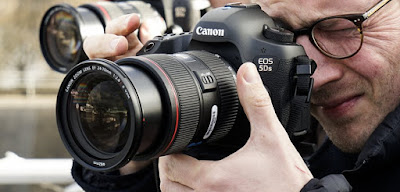The EOS 5DS R has a 50.6MP full-frame CMOS sensor powered by two Digic 6 processors. This lets the camera capture 8,688 x 5,792-pixel files at a very respectable 5 frames per second, just like the Sony A7R Mark II. The 50.6MP chip is the most pixels you can get in a DSLR or mirrorless camera, as of this writing.
Having used both the 5DS and 5DS R for a few months, we thought we would be familiar with using them. But we only just scratched the surface of their capabilities, and it will require months of experimenting to become familiar with all the menu options, such as the Fine Detail mode in the Picture Styles menu that gives access to Sharpness sub-settings. We’re sure studio photographers will have a ball with this, but since we’re not studio shutterbugs, all of our shots were handheld.
 |
| Canon EOS 5DS R |
Unlike Canon’s ultra-high-end pro DSLR, such as the $5,300 EOS-1D X, the 5DS R has a Smart Auto. Normally you would find this on entry- and mid-level DSLRs, so it’s surprising that Canon would put it on here. With that said, we have seen experienced photographers use this mode in situations where they just want to quickly capture a fleeting moment. There are also three custom options available on the dial, as well as a Bulb mode (used for long exposure).
The 5DS R has a native ISO range of 100-6,400 but you can hit 50 and 12,800 via expansion settings. The camera is an excellent low-light performer and our sample subject held up very well to ISO 3,200, and even 12,800 was usable. The built-in optical image stabilization of the zoom did a fine job keeping things steady and sharp.
You’ll find the hot shoe on the top deck, with a locking mode dial and on/off switch on one side, and on the other side, buttons for White Balance/Metering, Drive/AF type, Exposure Compensation/ISO, and lamp (for illuminating the mono LCD that shows shooting parameters). Toward the top of the grip are a jog wheel, an AF-area selection/Multi-function key, and an angled shutter button. Like other high-end Canon DSLRs, you won’t find a built-in flash. The two dominant features on the back are the large optical viewfinder with diopter control and 3.2-inch fixed-position LCD display (rated 1.04 million dots). The viewfinder offers 100-percent coverage with .71x magnification, and it’s excellent. The LCD, on the other hand, is adequate but not world class; studio photographers would attach laptops or monitors as their view screens anyway.
There are a lot of buttons on the back. To left of the LCD are Delete, Playback, Enlarge/Reduce, Rate, and Creative Photo/Two-Image Display (the latter functions are geared toward pros). Nearby are Menu and Info buttons; Live View Control for stills/video, as well as a center start/stop for recording; and AF-ON, AE Lock, and AF point selection. Given the camera has a 61-point AF system (41 cross-type), you can choose among any of them by using the joystick or jog wheel. We liked that the joystick is raised and easy to control. The nearby Q (Quick) key gives access to the available parameters, plus there’s a large control wheel with center Set button. Finally there’s a Multifunction Lock switch that prevents inadvertent camera adjustments.
On the right side is a compartment for two cards, CompactFlash and SD. The CF slot accepts Type-1/UDMA-rated media, and all SD cards can be used including SDXC. Although Canon doesn’t recommend the fastest cards available, we suggest you get one to speed the flow of 50.6MP files. The camera also supports USB 3.0 for faster file transfers.
No comments:
Post a Comment